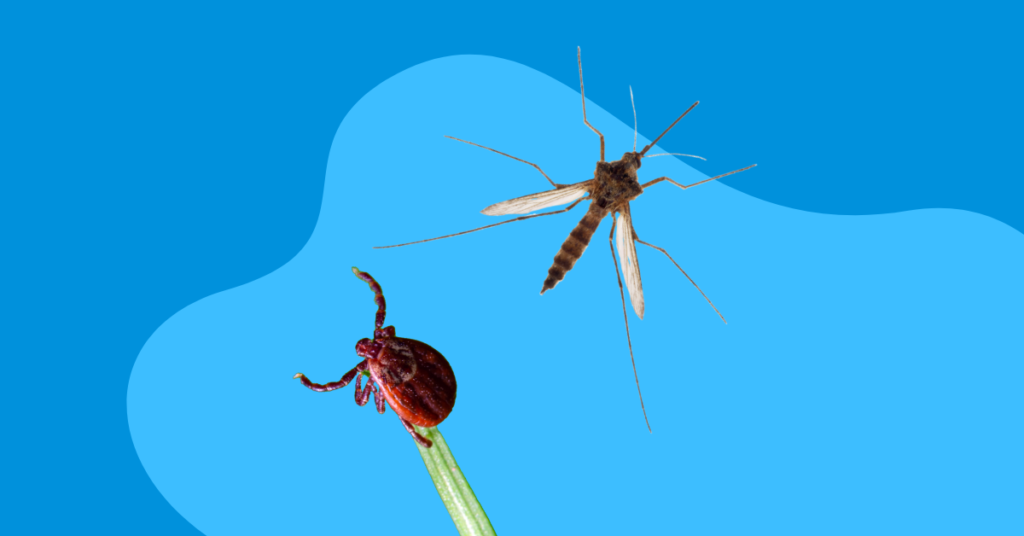As summer quickly approaches us, the weather invites us outdoors for warmth, sunshine, and activities. With all the fun that the season brings, there are some dangers that can significantly affect our health, especially for those who work outdoors. Two vermin in particular, ticks and mosquitoes, carry diseases spreading throughout even more of the U.S.
According to the CDC, 50,865 cases of tick-borne diseases were reported in 2019. As for mosquitoes, more than 2,000 cases of malaria are reported each year in the U.S. There are over 200 types of mosquitoes that live in the States, and 12 are capable of spreading disease.

Ticks and Mosquitoes Carry Vector-Borne Diseases
Vector-borne diseases are human illnesses caused by parasites, viruses and bacteria transmitted by vectors. Vectors can transmit infectious pathogens between humans, or animals to humans. Blood from an infected host can transmit infection to a new host. Ticks, mosquitoes, fleas, lice, and more are examples of vectors. Worldwide, these diseases account for more than 17% of all infectious diseases, causing more than 700,000 deaths yearly.
Ticks are often found in wooded areas, high grass, or leaf litter. They can transmit diseases like Lyme disease, babesiosis, and anaplasmosis. Mosquitoes are known for their itchy bites and can be found in weedy or wooded areas near standing water. Ticks and mosquitoes are vectors for the West Nile virus, malaria, dengue fever, and the Zika virus. Both are most active during the warmer months, with mosquitoes more prevalent during dawn or dusk.
Construction workers, landscapers, and agricultural workers are at an increased risk of being bitten by these vermin due to prolonged exposure in tick or mosquito-infested environments.
Ticks and Mosquitoes Spreading Across U.S.
In the past two decades, both Lyme disease and West Nile virus have expanded their reach to even more areas of the U.S. due to ticks and mosquitoes. According to data from the Centers for Disease Control and Prevention, there has been a reported surge of infections from tick, flea, and mosquito bites.
Part of this surge is due to ticks expanding their habitat due to changing land use and climate. A second reason for the spread is warming temperatures, encouraging more mosquito outbreaks and the diseases they carry to spread to new areas. This poses a new challenge for doctors and the public, who are not accustomed to these diseases.
Lyme disease is the most common tick and mosquito-borne disease in the U.S. The blacklegged tick that carries bacteria that can lead to Lyme disease has expanded its territory, causing an increase in infections. From 2011 to 2019, Pennsylvania saw a triple increase in Lyme disease cases.
Ticks pass from different hosts: deer, mice, and humans, allowing them to spread more bacteria and infect humans with Lyme disease. As host populations grow and winters grow warmer and shorter, ticks become more active and increase the risk of human encounters.
The spread of West Nile virus and other mosquito-borne diseases is unpredictable due to the mosquito’s short lifespan. West Nile virus first appeared in the U.S. in 1999 in New York City. After just five years, it stretched to most of the country and is now the leading cause of mosquito-borne illness. Infected migrating birds help spread the virus, as does warmer weather, which allows the virus to replicate faster.
• 264 deaths in 2003
• 286 deaths in 2012
• One-third of approx. 6,000 cases were reported in TX in 2012
• 227 deaths in 2021
• Maricopa County in AZ reported 1,487 cases, the most of any county
Protecting Yourself from Ticks and Mosquitoes
Some of the symptoms of vector-borne diseases include body/muscle aches, fever, headache, fatigue, joint pain, rash, stiff neck, or paralysis. If you experience these symptoms, seek medical attention promptly. There are ways to help prevent and protect yourself from infection and control your workplace from the risk of tick and mosquito-borne illness.
• Wear a hat and light-colored, long-sleeved shirts, and long pants
• Tuck your pants into your boots or socks
• Use insect repellants containing 20-50% on exposed skin
• Check body and clothing for ticks daily
• Immediately remove ticks with fine-tipped tweezers
• Wash and dry clothes using the hottest settings to kill ticks
Test your knowledge on staying safe from ticks with this quick, 10-question quiz.
Ways to Control Ticks & Mosquitoes for Outdoor Workers
• Remove leaf litter
• Mow or cut back tall grass and brush
• Discourage deer activity
• Place drain holes in containers that collect water
• Remove debris from ditches
• Fill in areas that collect standing water
• Remove, turn over, cover, or store equipment
As the summer months are near and the weather begins to warm, be protected, and prepared for the vermin and foes that these warmer months welcome. Between ticks, mosquitoes, fleas, snakes, and spiders, many creatures could pose a risk to your health. Find out more about the secrets to surviving venomous creatures in our webinar replay of Venomous Foes: Understanding Snakes & Spider Bites!
Charli Pedersen is a published writer featured on Axiom Medical’s blog. She holds a bachelor’s degree in English, Professional and Technical Writing, and has experience creating content for businesses and non-profit organizations.










